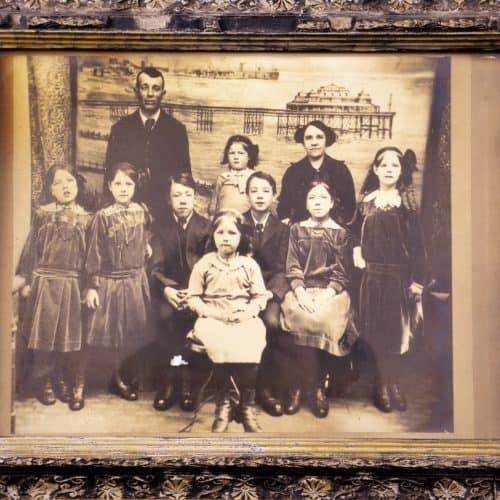Seaside Holidays activity 7: Victorian photographer’s studio
Pupils research Folkestone’s Victorian photographers and their work.
They set up a corner of the classroom as a photographer’s studio, including props and a painted backdrop. Customers, in Victorian costume, are welcomed into the shop and photographed as a piece of role play.
The children then design their own cabinet cards using the photos.
Learning objectives
Knowledge and understanding of the early history and process of photography, and the role of the Victorian seaside photographer. How to set up and take Victorian portrait photographs.
Curriculum links
KS1-2 Science (light, chemical change, the science of photography)
KS1-2 History (Local Area Study, seaside holidays).
KS1-2 Art and design (design a Victorian studio backdrop)
Use Learn with Objects Seaside Holidays 7: concertina as the starting point to investigate Victorian photographers in Folkestone.
Children should also research more widely. You may like to use some of the questions below as prompts.
- Who invented photography and when?
- What is a photograph? How were they made?
- When did photography first come to Folkestone?
- Do we know some of the Victorian photographers’ names?
- What equipment did they use?
- What did their photographs look like?
- What do their photographs reveal about Victorian Folkestone?
- What was it like in a Victorian photographer’s studio?
- What backdrops and props did seaside photographers use?
- Did they take photos outdoors too? Where?
- Why do people in Victorian photographs look serious?
- Why do some look blurred?
- What is a carte de visite?
- What is a cabinet card?
- What is a billhead?
After they have reported back on their research questions, small groups of children are given the different tasks highlighted below to set up the studio.
- Painting the backdrop (2m high x 2 metres wide)
- Making a mock up Victorian plate camera on a tripod
- Designing a shop sign to advertise the studio in Victorian script
- Designing the back of the cabinet card or carte de visite
- Creating seaside props that customers can hold (telescope, ships wheel, Victorian bucket and spade)
- Designing an advertising card or flyer for the studio.
- Creating an elaborate billhead for the hand-written bill.
The images below may be useful.


Role play: Victorian photographer's studio
- Two pupils play the part of the photographer and their assistant.
- Two more are outside touting for customers, among the holiday crowds, handing out advertising cards.
- Customers (pupils in Victorian costume) are welcomed into the studio and posed to capture their likeness for posterity.
- They choose props, are carefully positioned by the photographer, and must stay still for the long exposure. They must pay the bill before leaving.
- The photos are to be collected later once they have been developed.
This scenario could be developed and performed as a simple role play in front of the whole class.
Each pupil should have the opportunity to experience the studio both as customer and photographer. This could be done in small groups, throughout the course of a lesson (while everyone else is getting on with other work).
Top tip: ask a pupil to take a photo with a digital camera, on the black and white or sepia setting, at the same time the photographer pretends to take one with the mock up Victorian camera.
The photos are then printed out, along with the backs of the cabinet cards (and at exactly the same size) and glued either side of a thick piece of card.
Please note the standard size of a Victorian cabinet card was 108mm x 165mm.
Design your own design to advertise your studio, on the opposite side to the photo).
Learn with Objects links
See Learn with Objects Seaside holidays 7: concertina for information and ideas. There are also Victorian and Edwardian photographs of Folkestone in Seaside holidays 6, 10 and 14.


